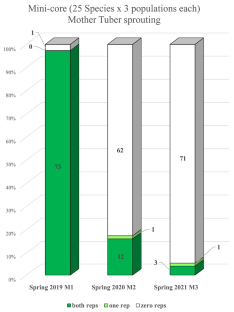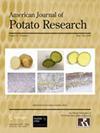Solanum jamesii (jam) is the only wild potato species with its natural range primarily within the USA. Its tubers are known to have unusual abilities to survive various environmental stresses. It has been observed during germplasm collecting that mother tubers (those that produced the plant) often appear to be as firm and viable as the new daughter tubers. This prompted investigation of whether such mother tubers can produce multiple seasons of shoots (after periods of intervening cool storage to simulate winter). We compared serial production of 20 cm shoots by the same tuber in subsequent seasons of a set of 162 jam populations to that of a diverse set of 75 populations of 25 other potato species in greenhouse cultivation at the US Potato Genebank. It was rare for tubers of any species other than jam to produce even two serial shoots. But over half of jam populations were able to produce four serial shoots (M4), and 14 populations produced five serial shoots (M5) with tubers remaining firm. When we looked for associated traits, M4 and M5 populations have no apparent single geographic origin or similarity by DNA markers. But natural origin sites for M4 and M5 populations were significantly associated with ancient human habitation. This work reports a new survival mechanism in potato by which a tuber does not expend all resources in maximizing new shoot growth, but instead presumably restocks itself to survive several seasons if all other reproductive options fail. Future work could study the physiological and genetic basis of the trait, and ways it could have practical benefit to the crop.



